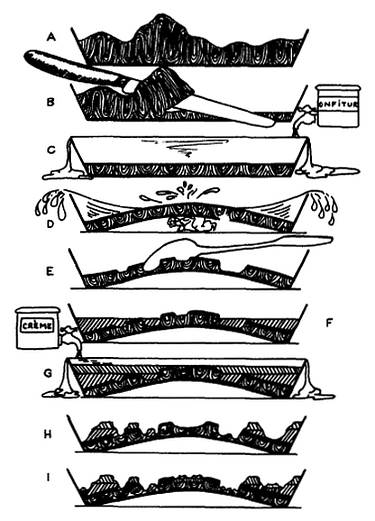
Sahara geology presented as a flan recipe, from French naturalist Théodore Monod’s Méharées: Explorations au vrai Sahara, 1937:
Take a flan-tray, which represents the basement (our Mauretanian and Tuareg granites).
- Place some pastry in the flan-tray in irregular masses (A) — these are the Precambrian mountain chains, the Saharides.
- Level this off with a knife (B) so that the folds, as in erosional peneplanation of the Sahara, are seen only in the ravines which cross the plain; the mountains are now vigorously planed down.
- First event: a tap (from which, fortunately, jam flows) floods the garnished mould (C). Similarly the sea at the beginning of the Palaeozoic invaded the Saharan basement, which it then partly occupied, until the middle Carboniferous — what an enormous amount of jam! All this time the Sahara is under water, and sandstones, limestones, conglomerates and shales were deposited — all the sediments of the Tuareg and Mauritanian plateaux.
- A new event (the djinns must have been at work here) — the bottom of the flan-tray experiences an uplift; the dish, pastry and jam emerge (D). This is the time of the coal measures; the sea retreats, and the Sahara is left high and dry, basking in the sun.
- But whoever says dry land, implies erosion; the sediments rise up, are corroded, and the spoon cuts so deeply that it exposes the jam, pastry, and sometimes even the metal of the flan-tray (E).
- And while this continues for millions of years, erosion is unable to evaporate its own debris and the eroded sediments are not washed away to the sea — they just accumulate, and what is lost in some districts is gained by others, whilst gradual infilling continues (F).
- Then one fine day, while iguanodons are blundering around in Picardy, and swarms of ammonites are scudding around in the Parisian sea, a second tap is turned on again and adds another layer, this time of cream (for convenience of explanation) (G). The sea re-invades a good part of the Sahara and deposits the usual sediments — Cretaceous and Eocene.
- A new retreat of the sea and a new continental phase occur, with customary erosion and deposition (H).
- Gradually, the country comes to be like it is today; sprinkle with granular sugar (fresh-water Quaternary deposits), and icing sugar dunes (I).
- And there we are! Serve hot or chilled.
“Very well — that will teach me to invent foolish nonsense for my neophyte when it is so easy to explain the influence of Saharidian tectonics on the orientation of Hercynian virgations, the suggestion of angular discordnce separating the basal congomerate of the continental beds from the post-Visean argillites, or more simply the origin of the bowlingite included in the pigeonite andesite with diabase facies of Telig. But I doubt that he would understand it any better …”
